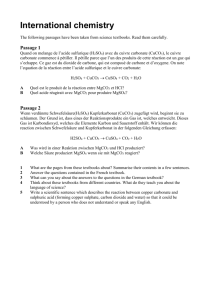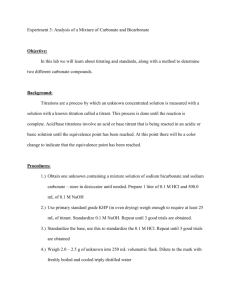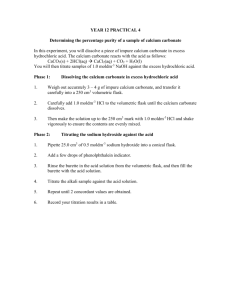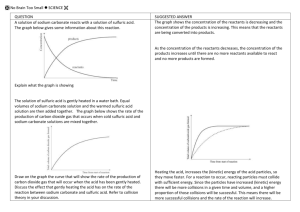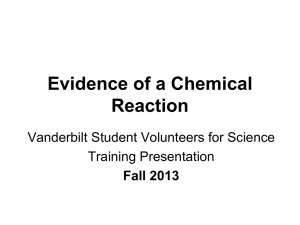Determination of carbonate ion (CO 3 2- ) An acid
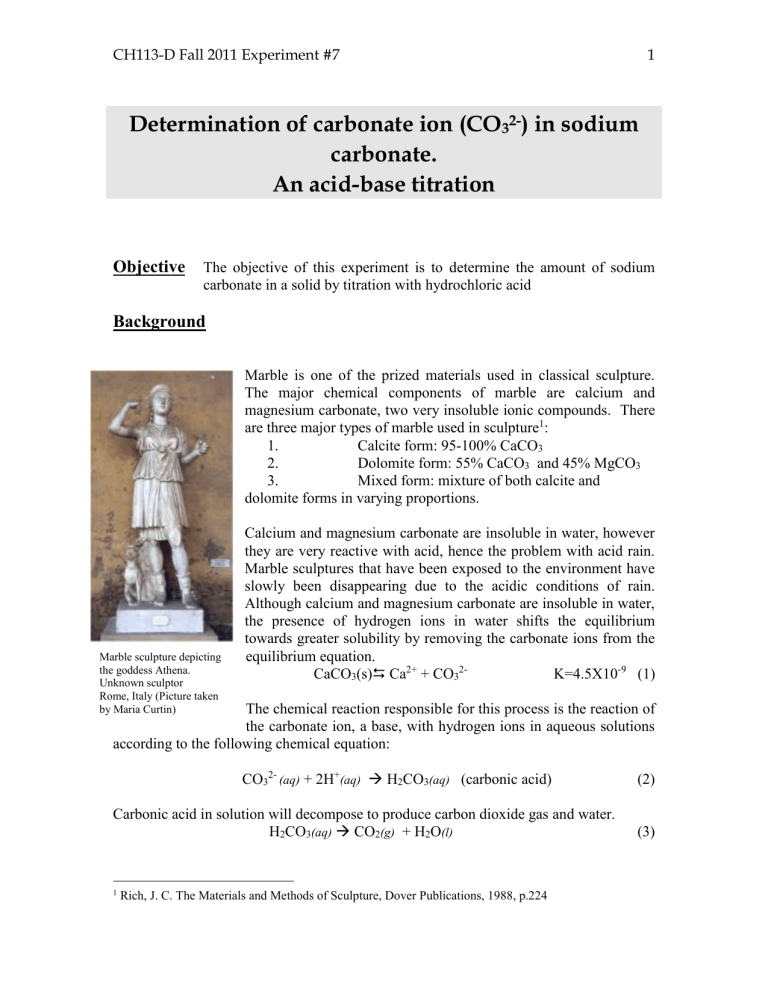
CH113-D Fall 2011 Experiment #7
Determination of carbonate ion (CO
32-
) in sodium carbonate.
An acid-base titration
Objective
The objective of this experiment is to determine the amount of sodium
Background
carbonate in a solid by titration with hydrochloric acid
Marble is one of the prized materials used in classical sculpture.
The major chemical components of marble are calcium and magnesium carbonate, two very insoluble ionic compounds. There are three major types of marble used in sculpture
1
:
1.
2.
Calcite form: 95-100% CaCO
3
Dolomite form: 55% CaCO
3
and 45% MgCO
3
3.
Mixed form: mixture of both calcite and dolomite forms in varying proportions.
Calcium and magnesium carbonate are insoluble in water, however they are very reactive with acid, hence the problem with acid rain.
Marble sculptures that have been exposed to the environment have
Marble sculpture depicting the goddess Athena.
Unknown sculptor
Rome, Italy (Picture taken by Maria Curtin) slowly been disappearing due to the acidic conditions of rain.
Although calcium and magnesium carbonate are insoluble in water, the presence of hydrogen ions in water shifts the equilibrium towards greater solubility by removing the carbonate ions from the equilibrium equation.
CaCO
3
(s)
Ca 2+ + CO
3
2 K=4.5X10
-9 (1)
The chemical reaction responsible for this process is the reaction of the carbonate ion, a base, with hydrogen ions in aqueous solutions according to the following chemical equation:
CO
3
2-
(aq)
+ 2H +
(aq)
H
2
CO
3
(aq)
(carbonic acid) (2)
Carbonic acid in solution will decompose to produce carbon dioxide gas and water.
H
2
CO
3
(aq)
CO
2
(g)
+ H
2
O
(l)
(3)
1
1 Rich, J. C. The Materials and Methods of Sculpture, Dover Publications, 1988, p.224
CH113-D Fall 2011 Experiment #7 2
The same principle responsible for the deterioration of marble statutes can be used in the laboratory to determine the amount of carbonate in a mixed solid. In this experiment we will determine the percent sodium carbonate (Na
2
CO
3
), in an unknown solid. Unlike calcium or magnesium carbonate, sodium carbonate is a very soluble ionic compound and will dissociate in water readily to produce sodium ions and carbonate ions. A known amount of the unknown solid will be dissolved and titrated with hydrochloric acid of known concentration. An acid base indicator will be used to determine the endpoint of the titration.
A titration is a technique in which carefully measured volumes of a substance called the titrant are added to a solution containing the compound of interest called the analyte . The titrant is chosen based on its reactivity with the analyte. The reaction of the titrant with the analyte must be of known stoichiometry and must be very fast, in other words the rate constant for the reaction must be very big . This is true for acid base neutralization reactions such as the reaction of carbonate with HCl.
The endpoint of the titration is the point at which when an additional small amount of acid is added to the solution a color change occurs indicating a drastic change in pH. The endpoint of the titration indicates the point at which the moles of acid added to the solution is equivalent to the moles of base in the solution. The moles of acid can be determined exactly by measuring the volume of the acid, of known concentration, added to the solution to the point of the color change. The moles of acid added to reach the endpoint therefore can be used to calculate the moles of base in the sample.
Moles of acid required to reach the endpoint equals the concentration of the acid times volume of acid added in Liters. moles= M x V (4)
In the reaction of carbonate with HCl, the carbonate requires two moles of acid for every mole of carbonate, as seen in equation (2). Therefore the moles of carbonate titrated equals the moles of HCl added up to the endpoint divided by 2 as follows:
Moles of CO
3
2= moles of HCl/2 (5)
The total weight of carbonate is calculated by multiplying the moles of carbonate obtained from the titration times the molar mass of sodium carbonate (Na
2
CO
3
).
The % Na
2
CO
3
is then calculated based on the grams of sample dissolved and titrated.
% Na
2
CO
3
in sample =(Na
2
CO
3
grams ( from titration) /grams of sample)x100 (6)
CH113-D Fall 2011 Experiment #7 3
Experimental Procedure
Glassware and equipment:
1 25-mL buret
1 50-mL beaker
1 125-mL Erlenmeyer flask buret stand and clamp
Stir/hot plate and magnetic bar
Chemicals:
HCl solution of known molarity
Sodium carbonate unknown
Methyl red indicator
Deionized water
Titration of sodium carbonate
1.
Weigh an appropriate amount of sodium carbonate solid (ask your instructor.)
Record the information in your notebook.
2.
Dissolve in 25 mL of water (use a graduated cylinder.)
3.
Fill the buret with the HCl solution carefully to the 0.0 mL mark. Make sure there are no bubbles in the buret, especially in the tip of the buret.
4.
Add a few drops of the Methyl red indicator to the dissolved unknown.
5.
Titrate with the acid until the methyl red indicator goes from yellow to red.
Record the volume required to reach this endpoint with as many significant figures as possible (Estimate the volume to the second digit after the decimal point.)
6.
Repeat steps (1) through (5) for two more samples.
7.
Calculate the % Na
2
CO
3
in the sample and record the information in your notebook.
8.
Calculate the average % and the standard deviation of your results.
9.
Complete the lab report form in the next page using the information in your notebook and pass it in before you leave the lab.
CH113-D Fall 2011 Experiment #7 4
CH113-D Fall 2011 Experiment #7 5
Determination of carbonate ion (CO
32-
)
An acid-base titration
Results
Sample # Weight of cup (g) Weight of sample + cup
(g)
1
Weight of sample
(g)
2
3
[HCl]=
Weight of sample (g)
Volume of
HCl (mL)
Moles of
HCl
Moles of carbonate
Grams of
Na
2
CO
3
% Na
2
CO
3 in sample
What is the average % sodium carbonate in your unknown sample?
What is the standard deviation of your results?
Were your results precise? Explain.
Student Name________________________________________________


